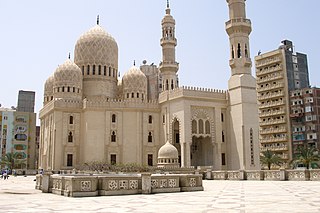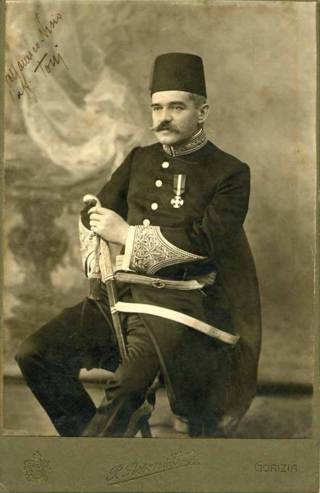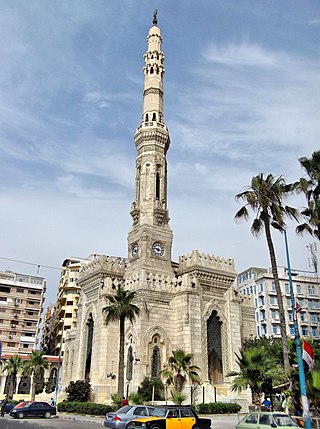


Mario Rossi (1897-1961) was an Italian architect and notable contributor to 20th-century Islamic architecture. [1]



Mario Rossi (1897-1961) was an Italian architect and notable contributor to 20th-century Islamic architecture. [1]
Rossi was born in Rome and studied architecture at the Accademia di Belle Arti di Roma, from which he graduated in 1917. He moved to Egypt in 1921 as an assistant decorator, invited by Ernesto Verrucci-Bey who was Chief Court Architect of Sultan (later King) Fuad, in charge of improvements at Abdeen Palace. He then worked for Egyptian Public Works, for Verrucci's successor Moustafa Fahmy, and with Antonio Lasciac on projects that included interior design, mansions, apartment buildings and mausoleums for a wealthy clientele.
In 1929, despite being a Catholic, he won the competition to become the Chief Architect of the Waqf Administration. In this capacity he designed a number of mosques and religious building between 1929 and 1941, most prominently in Alexandria. [2] He also worked on the restoration of older monuments, including the Mosque of Muhammad Ali and the Al-Rifa'i Mosque in Cairo.
Like thousands of other Italian Egyptians he was dismissed and expropriated during World War II at the initiative of the British authorities, and interned between 1941 and 1944 at Camp Fayed in the Suez Canal Zone. [3] In 1946 he converted to Islam, and in that period again worked for the Waqf Administration, now as an external consultant. He also designed the Islamic Center of Washington. [4] From 1954 to 1960 he worked in Saudi Arabia on the decoration of the Masjid al-Haram in Mecca. [5] He died in Cairo in 1961. [6]
He and his wife Rosa had a son, Alessandro. [7]
Rossi's architecture was based on careful study of ancient Islamic buildings in Egypt and beyond, particularly those from the Fatimid and Mamluk periods.
Rossi influenced a younger generation of Egyptian architects, such as Ali Thabit and Ali Khayrat who designed the Salah al-Din Mosque in El Manial, Cairo (1959). [9]
His Abu al-Abbas al-Mursi Mosque in Alexandria was a key source of inspiration for the Sheikh Zayed Grand Mosque in Abu Dhabi, designed by architect Yusef Abdelki and built between 1996 and 2007. [10] [11]

Cairo is the capital of Egypt and the city-state Cairo Governorate, and is the country's largest city, home to 10 million people. It is also part of the largest urban agglomeration in Africa, the Arab world and the Middle East: The Greater Cairo metropolitan area is the 12th-largest in the world by population with a population of over 22.1 million.

A caravanserai was a roadside inn where travelers (caravaners) could rest and recover from the day's journey. Caravanserais supported the flow of commerce, information and people across the network of trade routes covering Asia, North Africa and Southeast Europe, most notably the Silk Road. Often located along rural roads in the countryside, urban versions of caravanserais were also historically common in cities throughout the Islamic world, and were often called other names such as khan, wikala, or funduq.

Al-Rifa'i Mosque is located in Citadel Square, adjacent to the Cairo Citadel. Its name is derived from the Ali Abu Shubbak who is buried in the mosque. Now, it is also the royal mausoleum of Muhammad Ali's family. The building is located opposite the Mosque-Madrassa of Sultan Hassan, which dates from around 1361, and was architecturally conceived as a complement to the older structure as part of a vast campaign by the 19th century rulers of Egypt to both associate themselves with the perceived glory of earlier periods in Egypt's Islamic history and modernize the city.

The Museum of Islamic Art (MIA) in Cairo, Egypt is considered one of the greatest museums in the world, with its exceptional collection of rare woodwork and plaster artefacts, as well as metal, ceramic, glass, crystal, and textile objects of all periods, from all over the Islamic world.

The Sheikh Zayed Grand Mosque is located in Abu Dhabi, the capital city of the United Arab Emirates. It is the country's largest mosque, and is the key place of worship for daily Islamic prayers. There is a smaller replica of this mosque in Surakarta, a city in Indonesia.

There have been many architectural styles used in Egyptian buildings over the centuries, including Ancient Egyptian architecture, Greco-Roman architecture, Islamic architecture, and modern architecture.

Mohandiseen is a major 1940s sub-division project originally named Madinat al-Awqaf, and made up most of the Wasat (middle) district in the city of Giza, before being divided in 1997 into the districts of Agouza and Dokki. Al-Mohandessin in Arabic literally means the engineers, after one of the sub-districts that was sold to the Engineers' Syndicate cooperative, and becoming the colloquial name for most of the Agouza side.

The Abu al-Abbas al-Mursi Mosque is an Egyptian mosque in the city of Alexandria. The historic mosque is named after the 13th century mystic Abu'l Abbas al-Mursi, who is also buried in the same place along with members of the Ashraf family.
Al-Mursi Abu'l-'Abbas was a Sufi saint from Al-Andalus during the Nasrid period and who later in his life moved to Alexandria in Egypt. His complete name is Shahab al-Din Abu'l-'Abbas Ahmad ibn 'Umar ibn Mohammad al-Ansari al-Mursi. Al-Mursi Abul-'Abbas, as he is now commonly called, is one of the four master saints of Egypt, the other three being Ahmad al-Badawi, al-Dessouqi and al-Haggag. His legacy and reverence in Egypt were such that Mursi became a common name in the country.

The Ministry of Awqaf of Egypt is one of ministries in the Egyptian government and is in charge of religious endowments. Religious endowments, awqaf, are similar to common law trusts where the trustee is the mosque or individual in charge of the waqf and the beneficiary is usually the community as a whole. Examples of waqfs are of a plot of land, a market, a hospital, or any other building that would aid the community.

Antonio Lasciac (Italian) or Anton Laščak (Slovene) was an architect, engineer, poet and musician of Slovene descent, who designed the Khedive's Palace in Istanbul and the Tahra Palace in Cairo.

The Mosque of Abu al-Dhahab is an 18th-century mosque in Cairo, Egypt, located next to the Al-Azhar Mosque. It is a notable example of Egyptian-Ottoman architecture.
Ali Labib Gabr was an Egyptian architect who practiced during the second quarter of the 20th century. He was the first Egyptian Dean of the School of Architecture at Cairo University (1946-1955), and is noted for being a leading 'pioneer architect' in designing both workers housing and luxury villas, in particular that of Arab diva Om Kalthoum in the Cairo neighbourhood of Zamalek.
The Prince Amr Ibrahim Palace is a historical building in Cairo's Zamalek island, which is used as the Egypt's first ceramics museum, the Museum of Islamic Ceramics and as an art center.

Sulayman Pasha al-Khadem Mosque, also known as Sariat al-Jabal Mosque, is a historical mosque established in 1528 by Suleiman Pasha Al-Khadem, one of the Ottoman rulers of Egypt. It is located inside the Cairo Citadel at the top of Mount Mokattam, and originally erected for the use of the janissaries stationed in the northern enclosure. It is the first mosque established in Egypt in Ottoman architectural style.

The Mosque ofAmir Qijmas al-Ishaqi or Abu Hurayba Mosque is a late Mamluk-era mosque in Cairo, Egypt. It dates from 1480-81 CE and is located in the historic al-Darb al-Ahmar district, near Bab Zuweila. It is considered by many to be one of the finest examples of late Mamluk architecture.

The following outline is provided as an overview of and topical guide to Cairo:
Mursi may refer to:
Mahmoud Riad was a prolific Egyptian architect, urban planner, and housing policy maker. Over a four decade career, Riad designed and built many iconic buildings in New York, Cairo, Alexandria and Kuwait, and is considered a "foundational figure in twentieth century Egyptian architecture," and one of the 'pioneer' Egyptian architects. He held government positions in architecture and planning departments, and founded the Egyptian government's first high office for housing, the Department of Popular Homes.

Al-Qaed Ibrahim Mosque or the Commander Ibrahim Mosque in English, is a mosque in Alexandria, Egypt, in the Raml Station area.